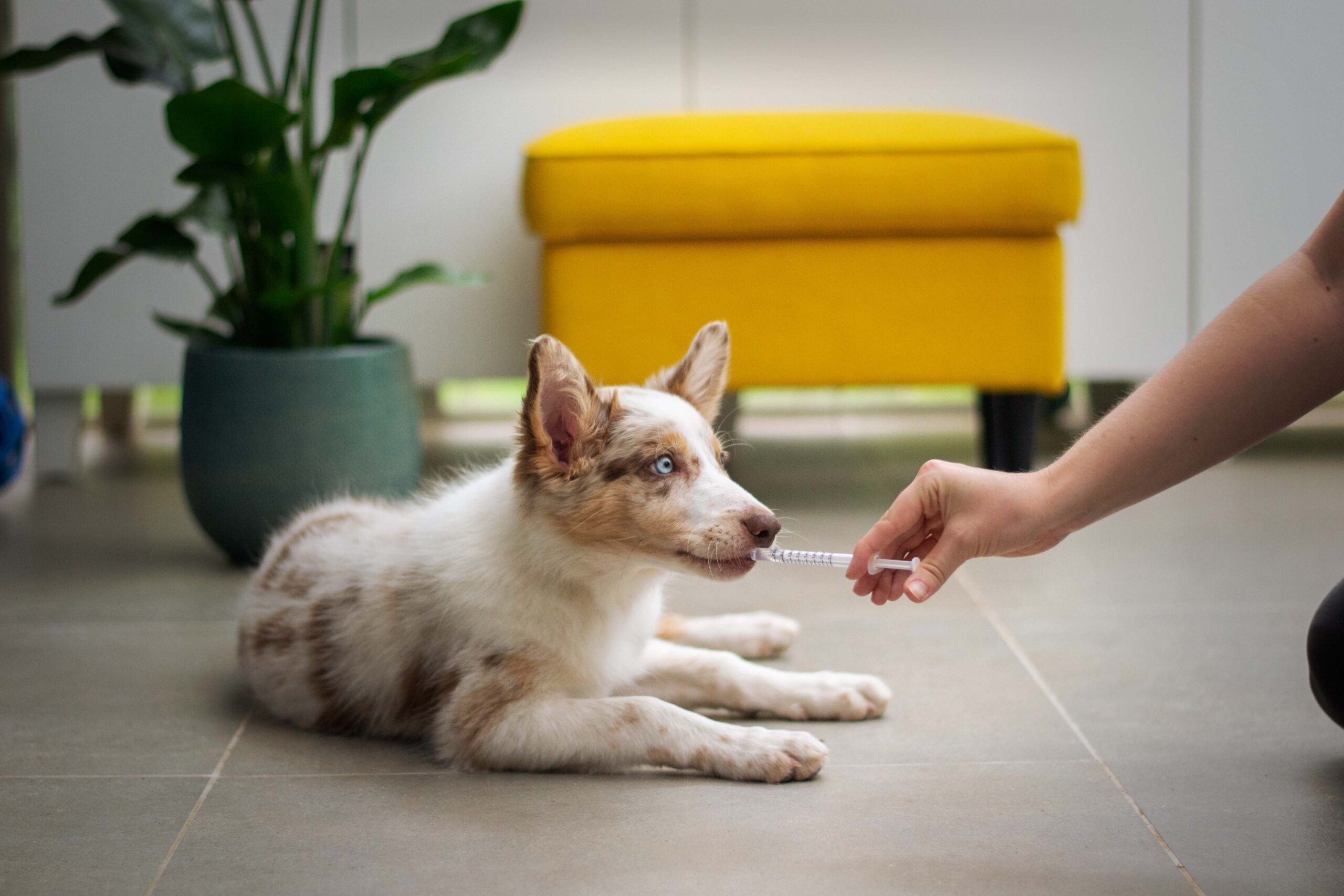
A visit to the vet doesn’t always have to be serious. However, even routine treatments like deworming or vaccinations contain antimicrobial chemicals. The improper use of these compounds could negatively impact your pet’s (and your) future health. As a vet nurse, I have seen the dangers of antibiotic resistance first-hand. Let’s look at what we as pet owners can do to reduce this threat.
The Discovery of Antibiotics
In 1928, Alexander Fleming, a Scottish bacteriologist, discovered penicillin by chance. On his return from a holiday, he found that a bacterial culture in a Petri dish had been infected and killed by a mould (penicillin). By the 1940s, derivatives of this fungus were used to treat wounded soldiers in the Second World War. But, by the end of the decade, resistance to penicillin had already been reported. The next 20 years saw an explosion in antimicrobial discoveries —representing more than half of the antibiotic drugs we use today.
Antimicrobial and antibiotic resistance
Pathogenic (harmful) microbes include bacteria, fungi, viruses and parasites. They have been around for millennia and, like all other living organisms, continually adapt to their environment. Antimicrobials are chemicals used to treat and prevent infection in humans, animals and plants. Resistance develops when microbes evolve and are no longer affected by the compounds intended to kill them. When referring to antimicrobial resistance (AMR), it is mostly bacterial resistance that is being discussed. However, like all living things, they belong to different classes and families—not all susceptible to the same methods of destruction.
Some medicines have stopped being effective against pathogenic microbes altogether. The World Health Organisation (WHO) stated that AMR is one of the top 10 global health threats facing humanity. And if it’s a threat to humans, it also threatens our pets.
The term ‘antimicrobial stewardship’
or AMS was first coined in 1996 by two internal medicine doctors. Their paper
suggested that to curb resistance, much greater attention and care would be
required by vets and doctors when making antimicrobial treatment
decisions.
AMR in the vet industry
Prudent Prescriptions
Worldwide, the veterinary industry has become more aware of just how often systemic antimicrobials are prescribed (often negligently where infection has not been proven but given ‘just in case’). Antimicrobial stewardship programmes are becoming more popular in the industry, slowly changing the habits that have led to the current crisis.
In many cases of antimicrobial infection (but not all), a combination of alternative treatments can bring about the same result as a course of antimicrobial tablets. This would only be in cases where harmful microbes were not threatening the life of a pet (sepsis). Infections of the skin, for example, are not life-threatening and can be treated without systemic drugs. In some cases, an antiseptic (a topical preparation of chemicals that prevents microbial growth but does not always kill them) combined with nutritional supplements like Omega oils, pro-biotics and strict hygiene control may often result in the same outcome as a course of antibiotics. Also, new medical techniques are emerging (like antimicrobial peptides, bacteriophages, LED-illuminated gel (LIG) and bacterial sprays) that provide alternatives to systemic drugs. These novel approaches provide pet owners with some relief. It means that scientists are slowly starting to think outside of the box—as opposed to just using chemical warfare as a cure-all. Simply put, the new ideas seek rather to reduce harmful microbes by using elements already present in the environment that out-compete the unwanted colonies rather than poisoning the entire system to kill one target species.
The meat industry is a major contributor to AMR too. Unfortunately, food production animals have been dosed with antibiotics since the 1940s and resistance is rapidly accelerating in this sector. Appropriate and prudent prescribing of antimicrobials is vital to curb AMR in this sector.
Inaccurate dosing
If you’ve been given antibiotics for your pet, the vet or nurse would have instructed you to complete the course. It should be noted that a bacterium (harmful or not) can replicate itself in minutes, growing exponentially if conditions are favourable. If your pet is under-dosed with antibiotics, bacteria are exposed to diluted/weak levels of active ingredients which may not be enough to kill them. They become stronger and potentially more resistant. Therefore, even if your pet looks healthy after a few doses of antibiotics, completing the prescribed medications is vital to eradicate harmful pathogens.
Have you ever held on to some leftover antibiotics, just in case? It’s understandable; they were probably expensive. However, as antibiotics age, they become less effective. Also, your ‘leftovers’ are probably not enough to make up another full course of treatment. Using the last few, old tablets to treat your pet instead of going to the vet again may seem tempting, but now you know why it’s a dangerous decision.
Perhaps you have a “demon pet”—one that will not tolerate tablets? Not surprisingly, the under-dosing of pets that are aggressive or fearful is a very common practice by pet owners. As hard as you might try, there is always wastage when battling to dose fractious animals and that too can lead to antimicrobial resistance.
Environmental poisoning
Rex was involved in a tussle with another dog. Thousands of rands and hours later, it looks as though he will live to fight another day. Half-used sprays and ointments, packets of tablets and other medication litter your cupboard—messy! You tip the pills into the toilet and you bin the rest because they can’t be recycled. Research indicates that apart from the drugs excreted through our urine and faeces, the disposal of pharmaceutical waste down the toilet is another huge source of environmental pollution and AMR. Unfortunately, pet owners are just as guilty of flushing veterinary drugs this way.
The veterinary health sector is also poisoning the environment with substances that cause AMR. Consider the hundreds of litres of antibacterial hand wash, surface cleaners, shampoos and detergents with powerful antimicrobial properties that are being washed down the drain—every second of every day—by veterinary clinics, laboratories, rescue organisations, zoos and animals sanctuaries (to name only a few). These diluted liquids are drained into our public waterways and oceans resulting in pathogens that are steadily becoming resistant.
Topical treatments for pets are also polluting our waters and causing AMR. Antimicrobial medication that targets skin parasites like ticks, fleas and mites are available as topical preparations like ‘spot-on’, powders, shampoos and sprays. When these chemicals wash off, they enter our environment in a weaker state. It’s not only harmful pathogens that are exposed to these compounds; non-target aquatic species are suffering from the cocktail of chemicals incessantly flowing into the ecosystem.
What can pet owners do to reduce AMR?
If you think that this crisis is big, you are right. However, if you think that there’s nothing you can do about it, you’re wrong. Generally speaking, problems start small, but the same can be said of solutions. If individuals act responsibly, their collective behaviour can bring about change. Here are some simple ways we can be part of the solution to AMR.
– Complete antimicrobial courses prescribed by your vet.
– Don’t use expired or leftover medication.
– Don’t self-prescribe medication for new infections in your pets because they worked before. Each infection must be properly assessed by the vet before a treatment decision is made.
– Practical hygiene habits in the home mean removing dirt before it becomes a source of infection. Remove your pet’s faeces, wash their blankets regularly and keep as much pet hair out of your home as possible.
– Bacteria thrive in warm, moist places. However, some types of ultraviolet light waves from the sun kill germs. Put blankets, mats, washed bowls and other pet accessories out in the sun to make use of this free, environmentally friendly service.
– Speak to your vet and enquire about alternative treatments to antibiotics where possible.
– Return unused medication to your vet to be disposed of properly.
– Use normal soap or environmentally friendly products instead of antibacterial cleaners in your home. Trying to kill bacteria in a home with pets around is like trying to keep sand out of the desert.
– Prevent topical medication from being washed off your pet into the environment by not bathing them for at least a week after treatment.
– Choose to eat animal protein that is organic and free from antibiotics.
– Feed your pets a suitable diet that includes different types of vitamins, minerals, proteins and fats. It will boost their immunity and enable them to fight minor infections without chemicals.
Think of superbugs, zombies, the apocalypse and flesh-eating bacteria that wipe out entire populations—it sounds like a horror movie but the message may not be far-fetched. Statistics published by WHO, The Lancet and other medical journals increasingly describe an alarming elevation in the numbers of resistant bacterial and viral types.
The International Committee of the World Organisation for Animal Health (OIE) published guideline documents in 2003. These documents outlined the public danger from AMR due to the overuse of antimicrobials in the veterinary industry for food animals. It took the South African government 13 more years to release a strategy document that set out how the veterinary industry would improve animal health so that animal-based products would be safer for human consumption (with AMR as one of the top priorities). There have subsequently been numerous publications on the subject, including Surveillance for Antimicrobial Resistance and Consumption of Antimicrobials in South Africa 2021—a lengthy and disturbing read that indicates a worsening situation.
The antimicrobial stewardship concept is not about forcing vets to stop using antimicrobial drugs, but about being more aware and vigilant when prescribing and only using them when absolutely necessary. We don’t need a government to tell us that AMR exists and we certainly don’t need a rule in place before we decide to act for the better. Vets and vet nurses are aware of the AMR crisis and it is our responsibility to educate pet owners about the danger of resistance. If we can make responsible and informed decisions for our pets’ health, there may be a chance that we can do the same for ourselves. As much as our actions have become a threat to our survival, so too can they become the solution to our redemption.
© Liz Roodt 2022
